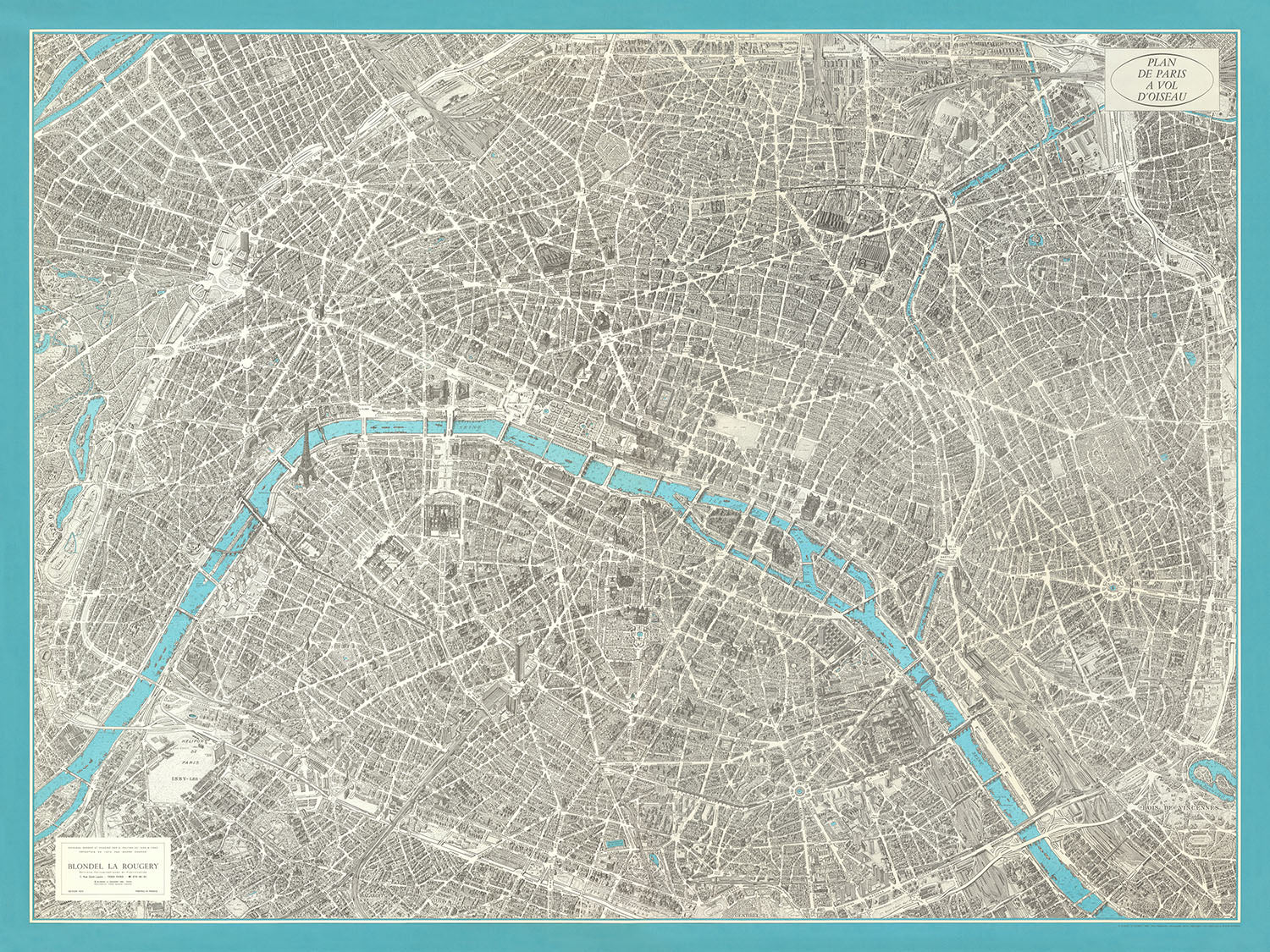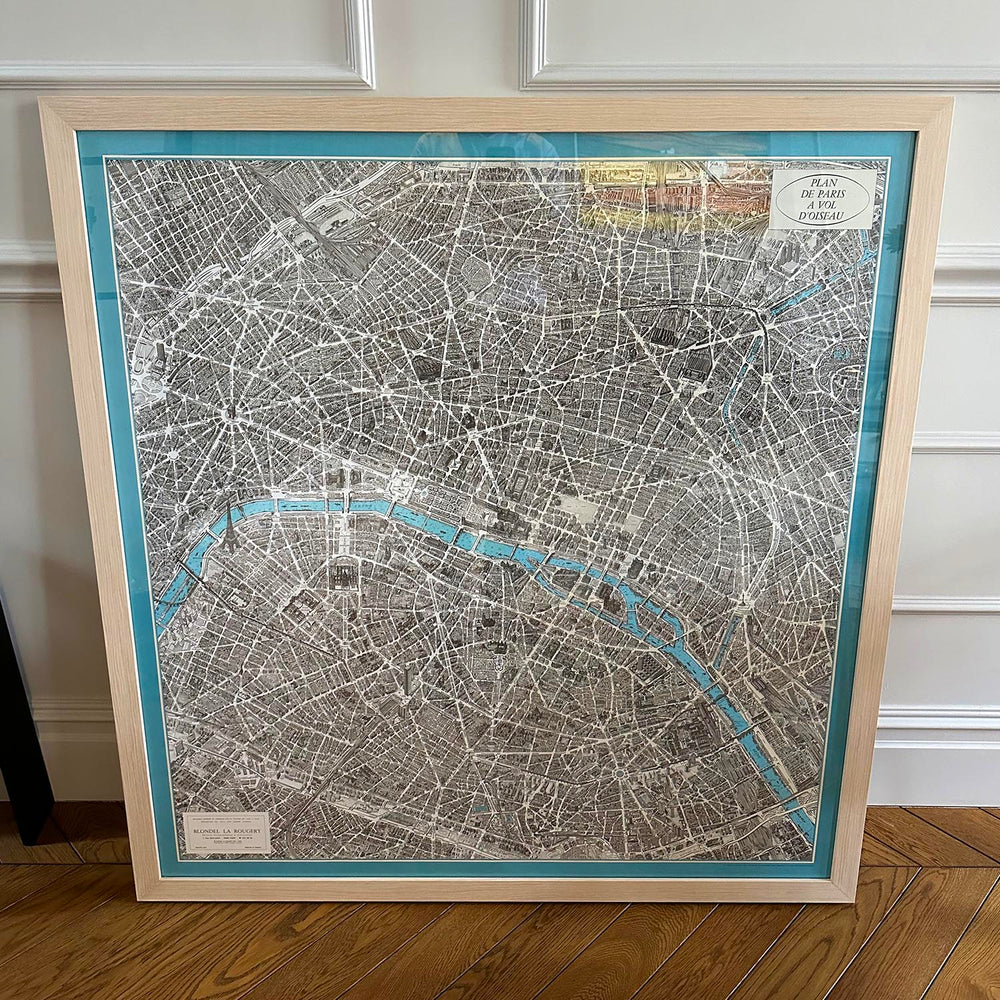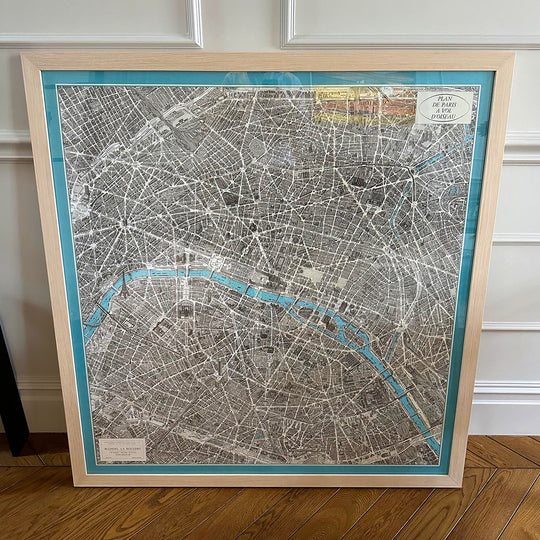- Handmade locally. No import duty or tax
- FREE worldwide delivery
- Love it or your money back (90 days)
- Questions? WhatsApp me any time
Own a piece of history
5,000+ 5 star reviews


The "Plan de Paris à Vol d'Oiseau," meticulously crafted by Blondel La Rougery and updated by André Chardon in 1974, offers a breathtaking bird's-eye view of Paris, capturing the city's intricate urban fabric and architectural splendor. Originally drafted by G. Peltier between 1920 and 1940, this map stands as a testament to Paris's evolution, chronicling its journey from a historical metropolis to a modern urban landscape. The detailed delineation of streets, squares, and the sinuous flow of the Seine River showcases the city's grandeur and complexity, making it an invaluable piece for enthusiasts of cartography and Parisian history alike.
This map is a visual chronicle of Paris's most iconic landmarks, including the Eiffel Tower, Arc de Triomphe, and Notre-Dame Cathedral. Each landmark is meticulously illustrated, reflecting the city's rich architectural heritage. The inclusion of cultural hubs like the Louvre Museum and the Panthéon further enhances the map's allure, offering a glimpse into the heart of Paris's historical and cultural epicenter. These landmarks not only define the city's skyline but also serve as enduring symbols of its artistic and historical significance.
Significant neighborhoods such as Montmartre, Le Marais, and the Latin Quarter are prominently featured, each with its unique charm and historical context. Montmartre, with its bohemian past and the iconic Sacré-Cœur Basilica, contrasts beautifully with the aristocratic elegance of Le Marais and the intellectual vibrancy of the Latin Quarter. These neighborhoods, with their distinct identities, collectively weave the rich tapestry of Parisian life, offering a window into the city's diverse cultural and social landscape.
The map also highlights Paris's extensive green spaces, including the Bois de Boulogne, Bois de Vincennes, Jardin des Tuileries, and Jardin du Luxembourg. These parks provide a verdant counterpoint to the urban environment, reflecting the city's commitment to preserving natural beauty amidst urbanization. The careful representation of these parks underscores their importance as oases of tranquility and recreation within the bustling metropolis, enhancing the map's depiction of Paris as a city that harmoniously blends nature and architecture.
Blondel La Rougery's "Plan de Paris à Vol d'Oiseau" is not merely a navigational tool but a work of art that encapsulates the essence of Paris. The map's artistic style, combining precision with aesthetic appeal, offers a timeless portrayal of the city's streets, boulevards, and riverbanks. It stands as a bridge between past and present, capturing the pulse of a city that has long been a nexus of culture, history, and art. For collectors and admirers of Paris, this map is a treasure that transports the viewer through the avenues of time, offering an unparalleled journey through the city's storied landscape.
Streets and roads on this map
- Avenue des Champs-Élysées
- Avenue de l'Opéra
- Avenue Foch
- Boulevard de Sébastopol
- Boulevard Haussmann
- Boulevard Saint-Germain
- Boulevard Saint-Michel
- Boulevard Voltaire
- Place de la Bastille
- Place de la République
- Place de l'Étoile
- Place du Châtelet
- Quai de la Tournelle
- Quai des Grands Augustins
- Quai des Orfèvres
- Quai du Louvre
- Rue de la Paix
- Rue de Rivoli
- Rue de Vaugirard
- Rue du Faubourg Saint-Antoine
- Rue du Faubourg Saint-Honoré
- Rue Lafayette
- Rue Saint-Denis
- Rue Saint-Honoré
- Rue Saint-Jacques
- Rue Saint-Martin
Notable Features & Landmarks
- Eiffel Tower
- Arc de Triomphe
- Notre-Dame Cathedral
- Sacré-Cœur Basilica
- Louvre Museum
- Place de la Concorde
- Panthéon
- Montmartre
- Le Marais
- Latin Quarter
- Saint-Germain-des-Prés
- Bois de Boulogne
- Bois de Vincennes
- Jardin des Tuileries
- Jardin du Luxembourg
Historical and design context
- Name of the map: Plan de Paris à Vol d'Oiseau (Bird's-Eye View Map of Paris)
- Original Creation Period: Drafted by G. Peltier between 1920 and 1940
- Update: Updated in 1974 by André Chardon
- Publisher/Mapmaker: Blondel La Rougery
- Themes and Topics:
- Urban Landscape: Depicts the intricate web of Parisian streets and the flow of the Seine River.
- Architectural Grandeur: Reflects the city's architectural evolution and historical heritage.
- Modernist Visions: Illustrates the juxtaposition of Paris's historical heritage with modernist urban planning, notably the influence of Le Corbusier’s 1929 Plan Voisin.
- Preservation vs. Modernization: Highlights the challenge of preserving Paris's 19th-century cityscape amidst modern urbanization pressures.
- Design/Style:
- Bird's-Eye View: Provides a detailed, aerial perspective of Paris.
- Delineation: Careful delineation of streets, squares, and the Seine River.
- Artistic and Functional: Balances artistic representation with functional navigation.
- Historical Significance:
- Urban Development Chronology: Chronicles Paris's urban development from the early 20th century to the mid-1970s.
- Cultural and Architectural Reference: Serves as a visual chronicle of Paris's growth, capturing the blend of historical and modern elements.
Please double check the images to make sure that a specific town or place is shown on this map. You can also get in touch and ask us to check the map for you.
This is a very large map that must be ordered at a large size, so that you can easily make out all of the details.
This map looks amazing at sizes all the way up to 100in (250cm). If you are looking for a larger map, please get in touch.
The model in the listing images is holding the 18x24in (45x60cm) version of this map.
The fifth listing image shows an example of my map personalisation service.
If you’re looking for something slightly different, check out my collection of the best old maps to see if something else catches your eye.
Please contact me to check if a certain location, landmark or feature is shown on this map.
This would make a wonderful birthday, Christmas, Father's Day, work leaving, anniversary or housewarming gift for someone from the areas covered by this map.
This map is available as a giclée print on acid free archival matte paper, or you can buy it framed. The frame is a nice, simple black frame that suits most aesthetics. Please get in touch if you'd like a different frame colour or material. My frames are glazed with super-clear museum-grade acrylic (perspex/acrylite), which is significantly less reflective than glass, safer, and will always arrive in perfect condition.
This map is also available as a float framed canvas, sometimes known as a shadow gap framed canvas or canvas floater. The map is printed on artist's cotton canvas and then stretched over a handmade box frame. We then "float" the canvas inside a wooden frame, which is available in a range of colours (black, dark brown, oak, antique gold and white). This is a wonderful way to present a map without glazing in front. See some examples of float framed canvas maps and explore the differences between my different finishes.
For something truly unique, this map is also available in "Unique 3D", our trademarked process that dramatically transforms the map so that it has a wonderful sense of depth. We combine the original map with detailed topography and elevation data, so that mountains and the terrain really "pop". For more info and examples of 3D maps, check my Unique 3D page.
For most orders, delivery time is about 3 working days. Personalised and customised products take longer, as I have to do the personalisation and send it to you for approval, which usually takes 1 or 2 days.
Please note that very large framed orders usually take longer to make and deliver.
If you need your order to arrive by a certain date, please contact me before you order so that we can find the best way of making sure you get your order in time.
I print and frame maps and artwork in 23 countries around the world. This means your order will be made locally, which cuts down on delivery time and ensures that it won't be damaged during delivery. You'll never pay customs or import duty, and we'll put less CO2 into the air.
All of my maps and art prints are well packaged and sent in a rugged tube if unframed, or surrounded by foam if framed.
I try to send out all orders within 1 or 2 days of receiving your order, though some products (like face masks, mugs and tote bags) can take longer to make.
If you select Express Delivery at checkout your order we will prioritise your order and send it out by 1-day courier (Fedex, DHL, UPS, Parcelforce).
Next Day delivery is also available in some countries (US, UK, Singapore, UAE) but please try to order early in the day so that we can get it sent out on time.
My standard frame is a gallery style black ash hardwood frame. It is simple and quite modern looking. My standard frame is around 20mm (0.8in) wide.
I use super-clear acrylic (perspex/acrylite) for the frame glass. It's lighter and safer than glass - and it looks better, as the reflectivity is lower.
Six standard frame colours are available for free (black, dark brown, dark grey, oak, white and antique gold). Custom framing and mounting/matting is available if you're looking for something else.
Most maps, art and illustrations are also available as a framed canvas. We use matte (not shiny) cotton canvas, stretch it over a sustainably sourced box wood frame, and then 'float' the piece within a wood frame. The end result is quite beautiful, and there's no glazing to get in the way.
All frames are provided "ready to hang", with either a string or brackets on the back. Very large frames will have heavy duty hanging plates and/or a mounting baton. If you have any questions, please get in touch.
See some examples of my framed maps and framed canvas maps.
Alternatively, I can also supply old maps and artwork on canvas, foam board, cotton rag and other materials.
If you want to frame your map or artwork yourself, please read my size guide first.
My maps are extremely high quality reproductions of original maps.
I source original, rare maps from libraries, auction houses and private collections around the world, restore them at my London workshop, and then use specialist giclée inks and printers to create beautiful maps that look even better than the original.
My maps are printed on acid-free archival matte (not glossy) paper that feels very high quality and almost like card. In technical terms the paper weight/thickness is 10mil/200gsm. It's perfect for framing.
I print with Epson ultrachrome giclée UV fade resistant pigment inks - some of the best inks you can find.
I can also make maps on canvas, cotton rag and other exotic materials.
Learn more about The Unique Maps Co.
Map personalisation
If you're looking for the perfect anniversary or housewarming gift, I can personalise your map to make it truly unique. For example, I can add a short message, or highlight an important location, or add your family's coat of arms.
The options are almost infinite. Please see my map personalisation page for some wonderful examples of what's possible.
To order a personalised map, select "personalise your map" before adding it to your basket.
Get in touch if you're looking for more complex customisations and personalisations.
Map ageing
I have been asked hundreds of times over the years by customers if they could buy a map that looks even older.
Well, now you can, by selecting Aged before you add a map to your basket.
All the product photos you see on this page show the map in its Original form. This is what the map looks like today.
If you select Aged, I will age your map by hand, using a special and unique process developed through years of studying old maps, talking to researchers to understand the chemistry of aging paper, and of course... lots of practice!
If you're unsure, stick to the Original colour of the map. If you want something a bit darker and older looking, go for Aged.
If you are not happy with your order for any reason, contact me and I'll get it fixed ASAP, free of charge. Please see my returns and refund policy for more information.
I am very confident you will like your restored map or art print. I have been doing this since 1984. I'm a 5-star Etsy seller. I have sold tens of thousands of maps and art prints and have over 5,000 real 5-star reviews. My work has been featured in interior design magazines, on the BBC, and on the walls of dozens of 5-star hotels.
I use a unique process to restore maps and artwork that is massively time consuming and labour intensive. Hunting down the original maps and illustrations can take months. I use state of the art and eye-wateringly expensive technology to scan and restore them. As a result, I guarantee my maps and art prints are a cut above the rest. I stand by my products and will always make sure you're 100% happy with what you receive.
Almost all of my maps and art prints look amazing at large sizes (200cm, 6.5ft+) and I can frame and deliver them to you as well, via special oversized courier. Contact me to discuss your specific needs.
Or try searching for something!


















































